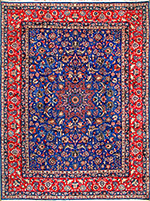Textiles Studies

Textile Research Works
Date of this Version
2012
Document Type
Article
Citation
Nexus Netw J – Vol.14, No. 2, 2012, pp. 251-273.
DOI 10.1007/s00004-012-0108-6;
Abstract
Of several brick tomb towers constructed at Maragha in western Iran before the Mongol conquests, one in particular, Gonbad-e Qabud (593 H. / 1196-97 C.E.), has generated significant recent attention for its unique patterns with pentagons and decagons. Gonbad-e Qabud is also unusual in having a decagonal plan. While both plan and decoration distinguish it from earlier and later towers at Maragha and elsewhere on the Iranian plateau, the ornamental patterns follow a long line of experimentation with geometric expressions that grace many pre-Mongol buildings in Iran. This article examines in particular the overlapping polygons and radial symmetries of the tympanum of the cubic Gonbad-e Sork (542 H. / 1148 C.E.) at Maragha, and the pentagons and squares of the tympanum of the later octagonal tomb tower (486 H. / 1093 C.E.) nearby at Kharraqan. Drawing from archival sources (plans, elevations, photographs), analysis of plane patterns, and comparative architectural data, this article reevaluates the cultural significance of Gonbad-e Qabud, seeking to situate it within the histories of mathematics, architecture, and the arts.
Included in
Art and Materials Conservation Commons, Art Practice Commons, Fiber, Textile, and Weaving Arts Commons, Indigenous Studies Commons, Museum Studies Commons


Comments
© 2012 Kim Williams Books, Turin